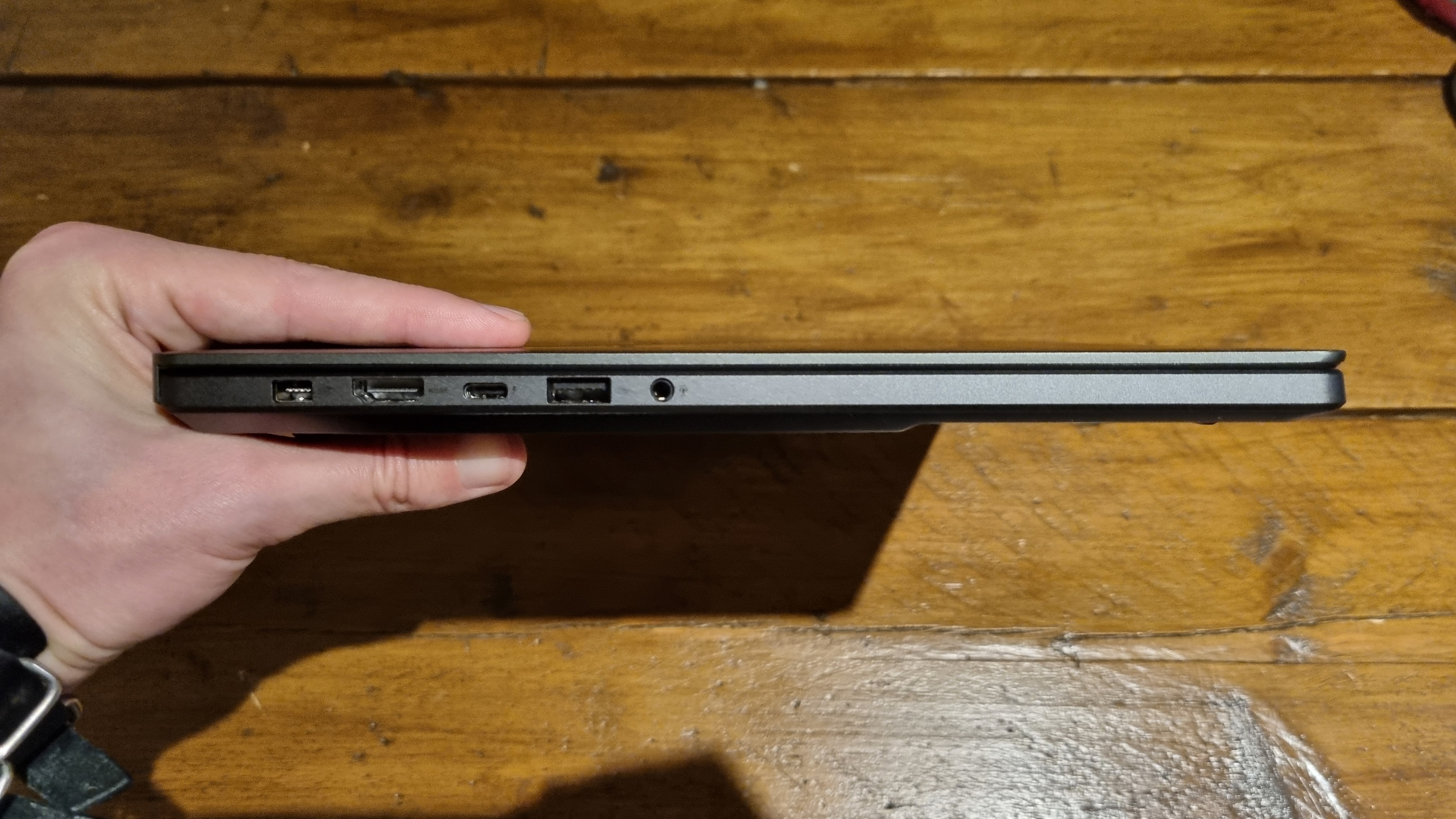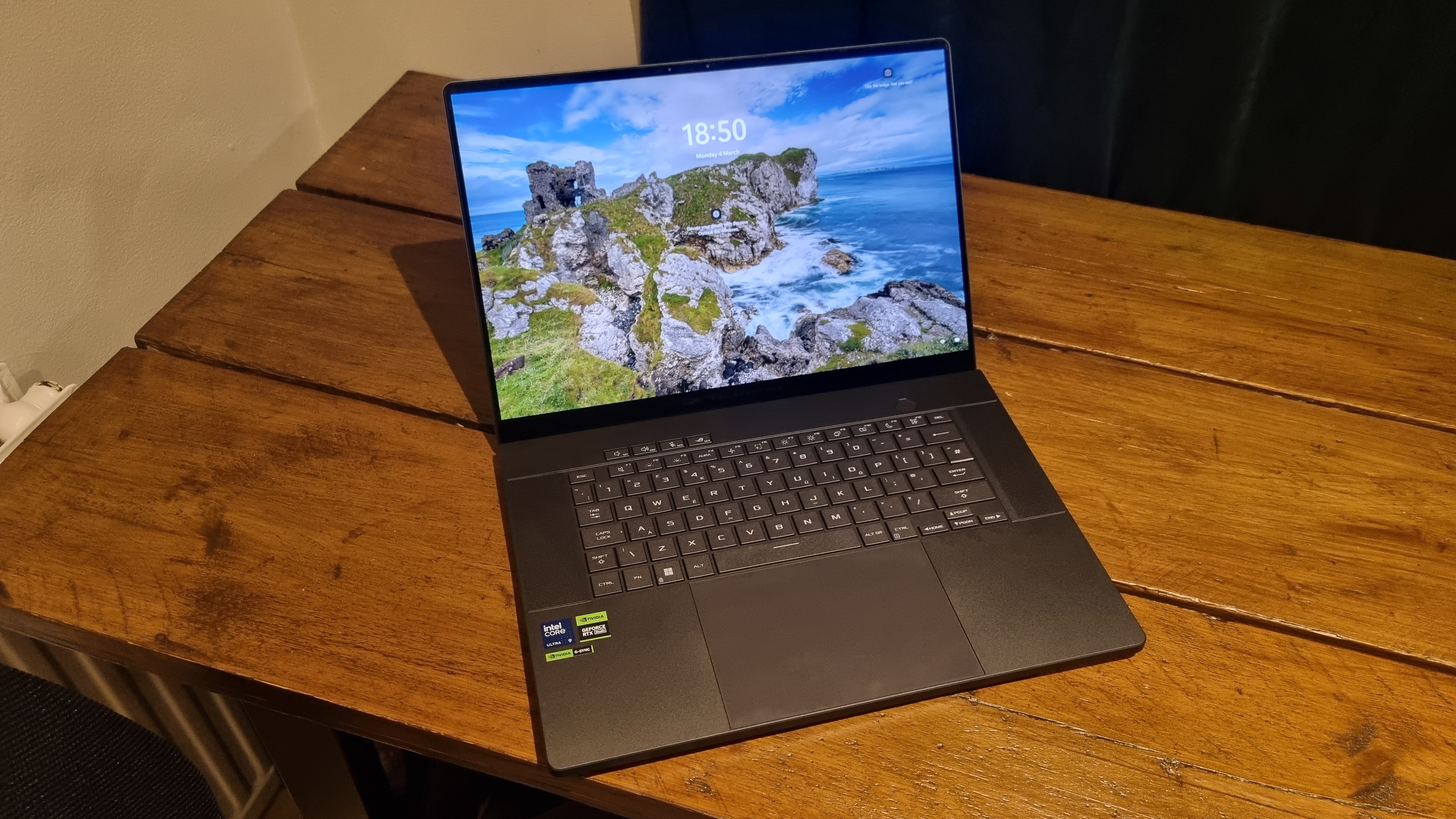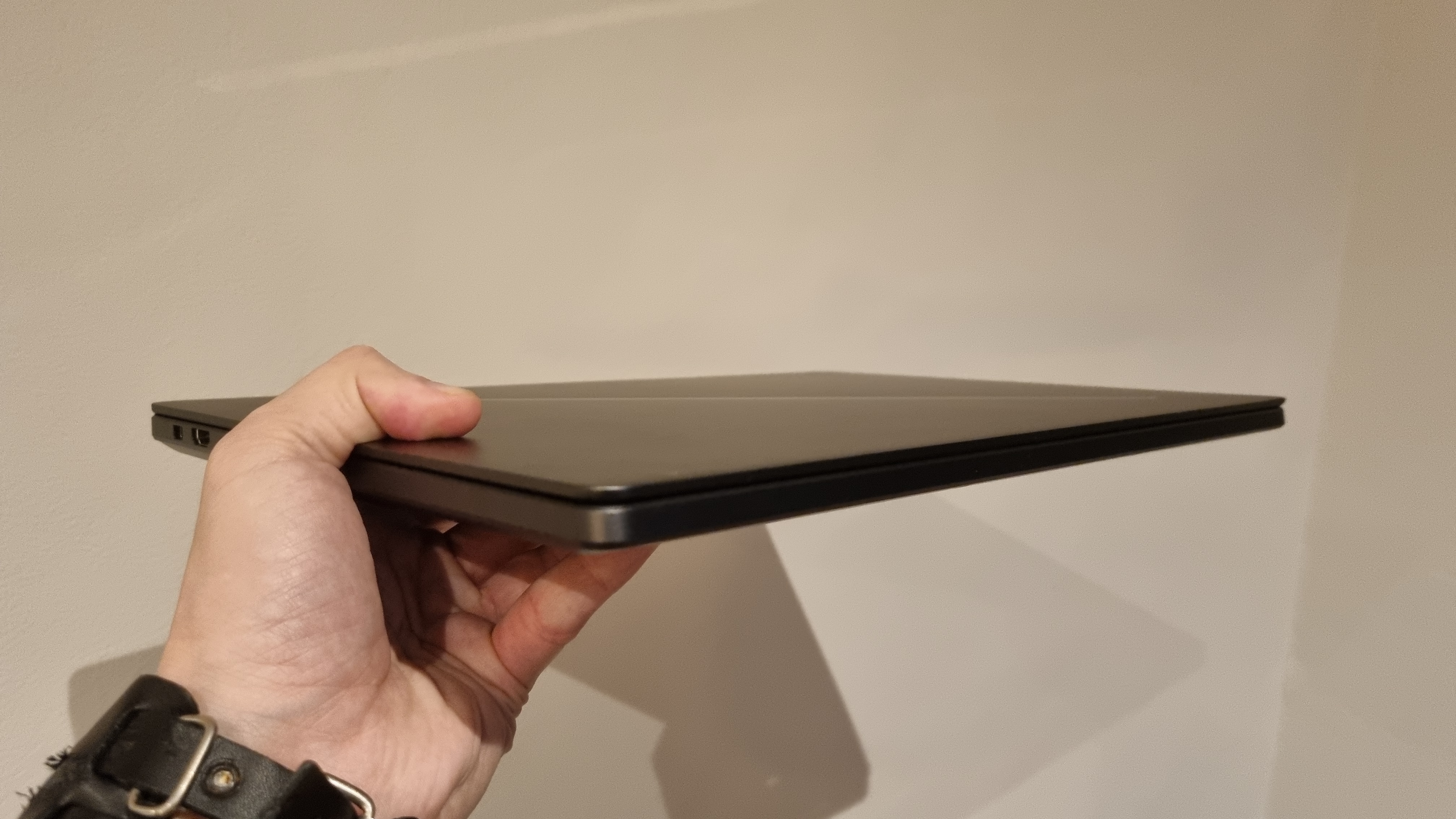Our Verdict
An endearingly usable, refined and polished experience, but with the RTX 4090 onboard it's still got too much high-end hardware for its own good.
For
- Super slim
- Excellent OLED
- Superb day-to-day useability
- Good speakers
- Premium-feeling chassis
Against
- RTX 4090 is hamstrung
- Expensive
- Slightly disappointing benchmarks
PC Gamer's got your back
Let's start off with a universal truth: When buying a gaming laptop, you have to make some compromises. One of the biggest is usually the trade off between portability and power, as while you can absolutely cram some high-end hardware into a slim frame, you'll inevitably have to accept some impact on gaming performance as a result.
The Asus ROG Zephyrus G16 2024 is slim. Surprisingly, almost astonishingly slim given the hardware inside. Upon pulling it from its box, I looked it over with a quizzical expression, turning it over and over in my hands. It's beautifully well-built, with a milled aluminium chassis that gives it a non-showy aesthetic, superb tolerances, and a premium feel that exudes quality and thoughtful design. So much so in fact, that its thin and professional-looking frame was enough to give me pause.
Surely this can't have an RTX 4090 inside, can it?
Why yes, yes it does. Not only does this particular version of the skinny Asus manage to crowbar the most powerful Nvidia mobile GPU into that minimal frame—albeit with a limited 115W TGP—it also pairs it with the top version of Intel's new Meteor Lake CPUs, the Core Ultra 9 185H with 16 cores and a rated P-core Turbo Boost frequency of 5.1GHz. Not only that, but you get 32GB of LPDDR5X-7467 RAM, 2TB of storage, and an ROG Nebula 16-inch OLED display, all for the substantial price of $3,300/£4,000.

CPU: Intel Core Ultra 9 185H
GPU: Nvidia RTX 4090
Memory: 32GB LPDDR5X 7467 RAM
Storage: 2TB NVMe SSD
Screen size: 16-inch ROG Nebula OLED
Resolution: 2560 x 1600
Refresh rate: 240Hz
Peak luminance: 500 nits
Battery: 90Whr
Dimensions: 35.4 x 24.6 x 1.49 ~ 1.74 cm
Weight: 1.95kg (4.29 lbs)
Price: $3,300 | £4,000
Gulp. That's a huge spec for such a slim machine, and one that makes you stare in wonder. The little lappy compels you to pass it around the room for inspection to check your eyes are not deceiving you, as fitting those sort of specs into a system you can very easily balance in one hand or chuck in your backpack for work is quite an achievement, and one that begins to raise suspicion.
Compromise is inevitable, it seems, although we'll get onto that in a minute.
Given the slim chassis and the mere 4.29 lb weight, the Zephyrus G16 is supremely portable. I carried it around with me for a couple of weeks to use as both a work laptop and a portable media machine, and found the whole experience to be remarkably civilised compared to some of the behemoths I've crammed into my backpack in the past. In regular unplugged usage the G16 runs quiet and cool, and sips its battery gently for the odd bit of office work on the train or some YouTube viewing, made all the better by that decently sized 16-inch screen.
A helpful addition for travelling is the inclusion of two separate power bricks, one full-fat 240W unit for maximum performance and a much smaller, lighter 100W model for travel purposes, cutting down on the need to bring a bulky charger along for the ride if you don't plan on gaming while out and about.
The expansive trackpad is a nice touch, and I found it responsive and smooth in all the right measures. While the keyboard isn't much to write home about it's decently sized with a good amount of key travel, even if it does initially appear to be squeezed between two quite sizeable speakers.





Speaking of, err, speakers, these are actually surprisingly punchy. While I wouldn't go as far as to say they could replace a portable Bluetooth unit, unlike most laptop speakers I've heard they actually have some genuinely meaningful bass and mid-range, enough to give you a bit of a kick underneath your wrists when listening to music or cranking up the game audio. Laptop audio is often truly terrible, so to have a couple of units here that can do a decent impression of heft was a welcome change, especially for the odd bit of movie viewing.
And when it comes to movie viewing, you've got that fabulous ROG Nebula OLED display. Like a lot of OLED screens it's not the brightest, and part of me wished Asus had gone for a Mini-LED panel like the Asus ROG Strix Scar 18 I recently reviewed, or even the 14-inch unit found in the 2023 Asus ROG Zephyrus G14. But while it's not going to deliver eye-searing highlights it's a beautifully deep and vibrant viewing experience. And, with a 240Hz refresh rate, it had absolutely no trouble keeping up with fast gaming action to boot.
Ah, now I've gone and done it. Fast gaming action. That means we'd better take a look at some benchmarks to see how the Zephyrus G16 performs under duress.
Hmm. While the Zephyrus G16 puts on a good showing at 1440p, managing to beat or come close to the Asus ROG Zephyrus G14 (2023) in many gaming benchmarks despite its slightly lower wattage version of the mobile RTX 4090, at 1080p it was behind the rest of the pack. Of note here is the Lenovo Legion Pro 7i with its 150W RTX 4080, which managed to beat out both of these small RTX 4090 laptops in almost every gaming benchmark we've tested.
The mobile RTX 4080 in the Lenovo is left to run at its full 150W TGP rating with a larger chassis and good cooling, and as a result has a habit of trouncing RTX 4090 laptops in our tests, although it is worth noting that the G16 and G14 sometimes provide better minimum frame rate numbers. Remember how I said sticking super-high end hardware in a very thin gaming laptop was always going to result in a compromise? That principle is on display here in the G16 and G14 figures, which is a bit of a shame given how much you're paying for the top end GPU here.

While its fans are less of a jet engine than its much bigger RTX 4090 sporting brother, in Turbo mode for best performance they're still fairly loud. I found the note less distracting than many I've heard, however, which is a good achievement given the slim form factor.
When it comes to productivity testing, the Zephyrus G16 faired reasonably well against the G14 thanks primarily to that Meteor Lake Core Ultra 9 185H CPU, although it's put firmly in its place by the Core i9 13900HX in the Legion Pro 7i. The Meteor Lake chip is an efficient performer, but simply can't stand up to the onslaught provided by the top end mobile Intel chip from the previous generation.
One phrase kept dominating my mind during my time with the G16: At what price portability? Certainly, compared to many of the RTX 4090 laptops we've tested, the Asus pulls off a rather impressive party trick stuffing all those top-end components into a laptop that's still thin, very portable and well-behaved.
✅ You're looking for portability: The Zephyrus G16
is very easy to get on with as a daily-driver, with a good compromise on screen size and chassis width that makes it a pleasure to carry around.
✅ You want a great screen: While it's a shame it doesn't have the Micro-LED of the previous 14-inch Zephyrus, the OLED panel here produces gorgeously deep colours and black levels, and a speedy 240Hz refresh rate.
✅ You like a refined aesthetic: The G16 is about as professional-looking as gaming laptops come, along with build quality and a fit and finish that reassures you that it's a premium product.
❌ You want top end performance: While the G16 is not what anyone would call slow, that RTX 4090 has had its wings clipped to fit in such a slim chassis, and the benchmark numbers reflect it.
❌ You're on a budget: At $3,300/£4,000 for this top spec model, those of you looking to save some cash would be better off speccing down the GPU or looking elsewhere.
But really, it runs into the same issue we've experienced with almost every RTX 4090 mobile laptop, namely that once you've taken that massively powerful GPU and stripped it down to a format where it can fit in something you can happily throw in your backpack, you have to strip the performance down to match, and given the slimline dimensions here that compromise is substantial.
Those of you hoping for a true bit of alchemy will be disappointed. Those two concepts, namely supreme portability and supreme performance, are rarely happy bedfellows, and here the benchmark numbers prove it once again. It's worth noting that the G16 is also available in RTX 4080, RTX 4070 and RTX 4060 configurations with the same CPU, and while we haven't been able to test them yet I'd put good money on the RTX 4080 version putting out similar performance results, for less cash and likely with a bit less heat and noise too.
It's simply the wrong GPU for such a small machine, although for what it's worth I really enjoyed my time with it. While I found the overblown nature of the Asus Strix Scar 18 with it's own (albeit much higher TGP) RTX 4090 to be ridiculous in all the wrong ways, in the Asus ROG Zephyrus G16 it was a much more endearing experience.
It's a little laptop with too much power for its own good, and while it didn't blow me away performance-wise its still a very quick machine in a supremely portable package with a good sized OLED screen, and there's something about that combo that tugs at my heartstrings a little. Call me sentimental if you must, but there's something almost amusing about it, like a puppy with paws too big for its diminutive frame. It behaves itself beautifully as a day-to-day driver, feels fantastic to use, has a wonderful screen in a very useable size for gaming, and slips into your backpack without notice.



On the other hand it's pricey, and it really could do with a less hamstrung GPU to bring it into line. But like a puppy that behaves itself for the most part then occasionally chews up your shoes, you can't get mad at it, not really.
While the 14-inch Asus ROG Zephyrus 2023 puts in similar figures, it's a little on the small side screen-wise for my tastes, and while the Lenovo Legion Pro 7i beats it handily in the benchmarks, it's still a bit chunky for carrying around day after day compared to the skinny Asus tested here. The Zephyrus G16 does have a combination that makes for a compelling offer regardless of its faults, as it's a still-very-powerful gaming laptop with excellent table manners, even if it hasn't perhaps succeeded in delivering the performance Asus might have hoped for.
I'd still have the cheaper model with a more reasonable GPU though. There, I said it. I'm sorry little Asus, but it's true, and we both know it.
An endearingly usable, refined and polished experience, but with the RTX 4090 onboard it's still got too much high-end hardware for its own good.

Andy built his first gaming PC at the tender age of 12, when IDE cables were a thing and high resolution wasn't—and he hasn't stopped since. Now working as a hardware writer for PC Gamer, Andy's been jumping around the world attending product launches and trade shows, all the while reviewing every bit of PC hardware he can get his hands on. You name it, if it's interesting hardware he'll write words about it, with opinions and everything.


